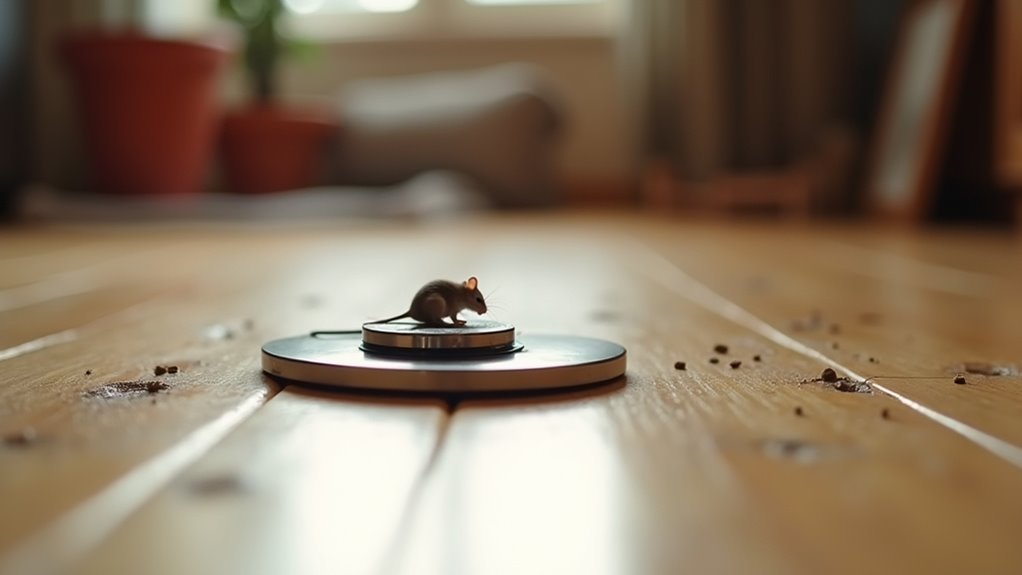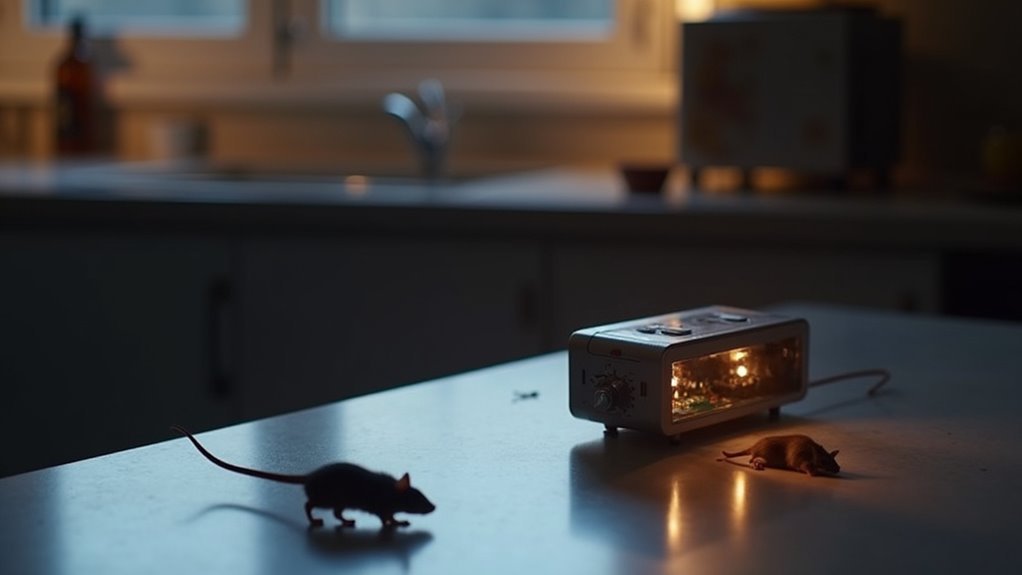You’ll catch mice most effectively by combining weight-activated pressure sensors with PIR motion detectors in a dual-verification system. This approach reduces false positives by up to 85% compared to single-sensor setups. Weight sensors detect physical presence while PIR sensors identify heat changes from warm-blooded rodents. For even better results, consider adding infrared beam interruption systems or camera-based detection with machine learning algorithms. The strategic integration of multiple technologies reveals thorough solutions for reliable rodent monitoring.
PIR Motion Sensors for Detecting Rodent Movement

When you’re dealing with a mouse problem, PIR (Passive Infrared) motion sensors offer an effective way to detect rodent movement by sensing changes in infrared radiation from their warm bodies.
PIR motion sensors detect mouse activity by sensing infrared radiation changes from their warm bodies, providing effective rodent movement detection.
These sensors trigger real-time alerts whenever they detect rodent activity, though larger animals can also activate them.
You’ll want to position PIR sensors strategically along walls and near entry points where mice typically travel.
This placement maximizes your detection efficiency and helps you identify problem areas quickly.
However, avoid placing sensors in direct sunlight, as bright light interferes with their function and causes false alarms.
While PIR sensors excel at initial detection, they work best when combined with other monitoring technologies rather than serving as your sole mouse trap solution for thorough rodent control.
Infrared Beam Interruption Systems
While PIR sensors detect thermal changes, infrared beam interruption systems work differently by creating an invisible barrier that triggers alerts when mice cross their path.
You’ll find these sensors use paired components that create a beam between them, making detection highly reliable with fewer false positives than other technologies.
Strategic placement along known mouse pathways maximizes effectiveness for thorough rodent control.
Here’s what makes these systems valuable:
- Precise Detection – The infrared beam only triggers when physically interrupted by mice
- Smart Integration – Remote monitoring capabilities send real-time alerts to your mobile device
- Versatile Installation – Works in both residential and commercial environments without invasive setup
You can monitor rodent activity continuously without traps, creating a non-invasive approach that fits seamlessly into modern pest management strategies.
Weight-Activated Pressure Sensors

Weight-activated pressure sensors offer a mechanical approach to mouse detection that relies on the physical mass of rodents triggering a response.
You’ll find these sensors effectively detect mice by measuring their weight when they step on the device, providing reliable confirmation of rodent activity. These weight-activated pressure sensors integrate seamlessly into rodent traps and monitoring stations, delivering real-time alerts that enhance your pest control efficiency.
You can combine pressure sensors with other detection methods to improve accuracy and minimize false positives in your integrated pest management system.
The quick response time enables immediate action once mice presence is confirmed. These sensors excel at detecting larger rodents like rats and mice, thanks to their sensitivity in differentiating between animal weights and environmental disturbances.
Camera-Based Detection With Machine Learning
You’ll need sophisticated image recognition algorithms to accurately distinguish mice from other moving objects like insects or debris in your monitoring area.
Your system must process video feeds in real-time, which requires balancing detection accuracy with computational speed to avoid missing quick rodent movements.
Consider using TensorFlow Lite on platforms like Raspberry Pi or ESP32 to achieve the processing power needed for continuous analysis without overwhelming your hardware’s capabilities.
Image Recognition Algorithms
Modern image recognition algorithms transform ordinary cameras into intelligent rodent detection systems by leveraging machine learning techniques that can accurately identify mice in real-time.
You can implement these advanced systems using platforms like TensorFlow Lite, which train models to differentiate between rodents and non-target objects, considerably reducing false alarms.
Here’s how image recognition enhances rodent monitoring:
- Real-time Processing – Raspberry Pi-powered cameras analyze visual data instantly, triggering immediate alerts when detecting mouse movement.
- Continuous Learning – Algorithms improve accuracy through diverse dataset training, recognizing different species and behaviors effectively.
- Automated Analytics – Advanced systems log data automatically and perform trend analysis to inform your pest management strategies.
You’ll find that continuous algorithm training with varied datasets creates more reliable monitoring solutions for thorough rodent detection.
Real-Time Processing Requirements
When implementing camera-based rodent detection, you’ll need sufficient computational power to process video feeds without the latency that compromises detection accuracy.
Real-time processing demands robust hardware setups with adequate computational power and storage capacity to handle multiple camera feeds effectively. You can implement TensorFlow Lite on devices like ArduinoBLE or ESP32 to facilitate efficient video feed processing, enabling detection and classification without significant delays.
Your machine learning models require training with diverse datasets of rodent behavior to achieve high accuracy in detecting rodent activity.
High-definition cameras like the Wyze Cam v3 capture clear footage of fast-moving rodents when set for continuous recording. As your deployed system gathers more data, detection accuracy improves, making real-time identification of rodent activity increasingly reliable and immediate.
Ultrasonic and Microwave Sensor Technologies

Technology offers two distinct sensor approaches for mouse detection and deterrence: ultrasonic and microwave systems.
You’ll find ultrasonic devices emit high-frequency sound waves that disrupt mice’s auditory systems, creating an inhospitable environment that drives them away. Microwave sensors detect motion using electromagnetic waves, covering broader areas and penetrating obstacles more effectively than ultrasonic alternatives.
Consider these key differences when choosing your pest control solution:
- Range limitations – Ultrasonic devices cover 20-30 feet while microwave sensors monitor larger areas through walls.
- Long-term effectiveness – Mice may become habituated to ultrasonic sounds over time, but microwave sensors maintain consistent performance.
- Detection capability – Microwave sensors reliably catch small movements, while ultrasonic systems focus on deterrence rather than detection.
Both technologies provide humane, non-lethal approaches to managing rodent activity in your space.
Trail Cameras for Continuous Monitoring
While sensor technologies excel at detection and deterrence, trail cameras offer a thorough visual approach to understanding mouse behavior in your space. These monitoring devices capture real-time footage of rodent activity, revealing entry points, movement patterns, and infestation severity.
| Feature | Benefit | Requirement |
|---|---|---|
| Motion Detection | Conserves battery and storage | Automatic activation |
| Infrared Night Vision | Monitors nocturnal rodents | Low-light capability |
| Species Identification | Targeted pest control | Clear image quality |
| Entry Point Mapping | Strategic trap placement | Wide-angle lens |
| Activity Frequency | Assessment timing | Continuous operation |
You’ll need a minimum 64GB high endurance microSD card, though 128GB works better for extended periods. Trail cameras help you identify specific rodent species and their behavioral patterns, enabling more effective pest control strategies.
Multi-Sensor Integration for Enhanced Accuracy
You’ll achieve superior rodent detection accuracy by combining PIR sensors with infrared beam technology, creating overlapping coverage that captures different movement patterns and eliminates blind spots.
Weight sensors paired with motion detection provide dual verification – confirming both physical presence and movement simultaneously to dramatically reduce false alarms.
This multi-sensor fusion approach lets you cross-reference data streams in real-time, ensuring you’re detecting actual rodent activity rather than environmental interference.
Combining PIR and Infrared
Two sensors working together can greatly improve your mouse detection results compared to relying on a single technology.
PIR sensors excel at detecting heat changes from warm-blooded rodents, while infrared beam sensors precisely monitor interruptions in light beams. This combination creates a multi-layered detection system that notably reduces false positives.
Here’s how this dual-sensor approach enhances your monitoring:
- Complementary Detection Methods – PIR sensors catch heat signatures while infrared beam sensors detect physical movement interruptions.
- Environmental Interference Reduction – When sunlight affects PIR sensors, infrared beam sensors continue functioning reliably.
- Strategic Placement Optimization – Position sensors at entry points and known pathways to eliminate blind spots.
Machine learning algorithms can analyze data from both sensors, distinguishing genuine rodent activity from environmental disturbances for maximum accuracy.
Weight and Motion Fusion
Weight sensors add another powerful dimension to your mouse detection arsenal by measuring the physical pressure rodents exert when they step onto monitoring platforms. When you combine weight sensors with motion sensors, you’ll create a dual-verification system that dramatically reduces false positives while ensuring accurate rodent detection.
| Sensor Type | Detection Method | Accuracy Level |
|---|---|---|
| Weight Only | Pressure measurement | Moderate |
| Motion Only | Movement detection | Low (false positives) |
| Weight + Motion | Dual verification | High |
This multi-sensor integration requires both movement and sufficient weight to trigger alerts, eliminating false activations from dust, vibrations, or small insects. You’ll receive more reliable notifications when actual rodent activity occurs, making your monitoring system both efficient and trustworthy for thorough pest management.
Frequently Asked Questions
What Is the Most Effective Trap for Mice?
You’ll find electric traps like Victor No Touch or OWLTRA most effective, delivering 6,000-9,000 volt kills with sensor technology. They’re pricier but offer hands-free disposal and higher success rates than traditional snap traps.
What Is the Most Effective Mouse Control Method?
You’ll find electronic snap traps combined with multiple sensors offer the most effective mouse control. They provide quick kills, no-touch disposal, and real-time monitoring capabilities that enable proactive pest management before infestations escalate.
What Do Professionals Use for Mouse Traps?
You’ll find professionals use electronic traps like Victor No Touch, mechanical options like Tomcat Press N Set, and integrated monitoring systems like TrapSensor for thorough rodent control strategies.
What High Frequency Keeps Mice Away?
You’ll want frequencies between 20-65 kHz to repel mice effectively. However, mice can adapt to constant sounds over time, and these frequencies don’t penetrate walls well, limiting their long-term effectiveness.
In Summary
You’ll achieve the best results by combining multiple sensor technologies rather than relying on a single detection method. PIR sensors offer excellent movement detection, while pressure sensors catch subtle weight changes. Camera systems with AI provide visual confirmation, and ultrasonic sensors fill coverage gaps. Trail cameras give you continuous monitoring capabilities. By integrating these technologies, you’ll create a thorough detection system that catches mice more effectively than any standalone sensor.





Leave a Reply